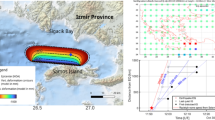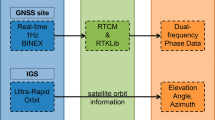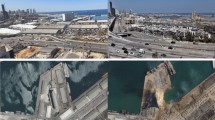Abstract
Co-seismic ionospheric disturbances (CIDs) can help understand the coupled dynamics of earthquake-atmospheric coupling geophysical processes. On September 19, 2022, an earthquake occurred at UTC = 18:05:08 near the Pacific Coast of Mexico as the result of shallow thrust faulting with magnitude of 7.6 and depth of around 26.9 km. The epicenter of the earthquake is located at (18.455°N, 102.956°W). In this study, observation data from the global navigation satellite system (GNSS) are used to identify CIDs about 12 min after the earthquake occurred. The significant CIDs signals are observed with extending outward from the epicenter. The CID characteristics like amplitude, frequency, and waveform are also investigated and discussed. The waveform is a standard and inverse N-type, suggesting a connection to plate movement and geomagnetic field. In addition, the center frequency is within the range of acoustic wave frequency from 2 to 4 mHz. The propagation speed is approximately 0.81 km/s for PRN G18, 1.01 km/s for G23, and 1.16 km/s in the east and 1.44 km/s in the west for G32 between 18:00 and 19:00. For R21, the propagation speed is close to 1.06 km/s. It demonstrates that the main source of the CIDs is the acoustic wave. Also, it is discovered that the CID propagation velocity varies significantly depending on the azimuth. At the direction closed to the strike angle (287°), the maximum propagation speed is found. The rupture mainly occurred in the western region, and the rupture velocity is larger in the western region, which might cause the quicker CID in this direction.














Similar content being viewed by others
Data availability
The space weather index can be obtained at https://spdf.gsfc.nasa.gov/. The GNSS observation data from UNAVCO are available at https://www.unavco.org/data/. And precise orbit products are from CDDIS (https://cddis.nasa.gov/). The focal mechanism is obtained from U.S. Geological survey (https://earthquake.usgs.gov/earthquakes/eventpage/us7000i9bw/moment-tensor) and IRIS (http://ds.iris.edu/spud/momenttensor/20746202).
References
Afraimovich EL, Perevalova NP, Plotnikov AV, Uralov AM (2001) The shock-acoustic waves generated by earthquakes. Ann Geophys 19(4):395–409. https://doi.org/10.5194/angeo-19-395-2001
Artru J, Farges T, Lognonne L (2004) Acoustic waves generated from seismic surface waves: propagation properties determined from Doppler sounding observations and normal-mode modelling. Geophys J Int 158(3):1067–1077. https://doi.org/10.1111/j.1365-246X.2004.02377.x
Astafyeva E, Heki K (2009) Dependence of waveform of near-field coseismic ionospheric disturbances on focal mechanisms. Earth Planets Space 61:939–943. https://doi.org/10.1186/BF03353206
Astafyeva E, Heki K, Vladislav K, Afraimovich E, Shalimov S (2009) Two-mode long-distance propagation of coseismic ionosphere disturbances. J Geophys Res Space Phys 114(A10):A10307. https://doi.org/10.1029/2008ja013853
Astafyeva E, Shalimov S, Olshanskaya E, Lognonné P (2013) Ionospheric response to earthquakes of different magnitudes: larger quakes perturb the ionosphere stronger and longer. Geophys Res Lett 40(9):1675–1681. https://doi.org/10.1002/grl.50398
Astafyeva E, Rolland LM, Sladen A (2014a) Strike-slip earthquakes can also be detected in the ionosphere. Earth Planet Sci Lett 405:180–193. https://doi.org/10.1016/j.epsl.2014.08.024
Astafyeva E, Yasyukevich Y, Maksikov A, Zhivetiev I (2014b) Geomagnetic storms, super-storms, and their impacts on GPS-based navigation systems. Space Weather 12(7):508–525. https://doi.org/10.1002/2014sw001072
Bagiya MS, Sunil A, Rolland L, Nayak S, Ponraj M, Dhanya T, Durbha SR (2019) Mapping the impact of non-tectonic forcing mechanisms on GNSS measured coseismic ionospheric perturbations. Sci Rep 9(1):18640. https://doi.org/10.1038/s41598-019-54354-0
Bird P (2003) An updated digital model of plate boundaries. Geochem Geophys Geosyst 4(3):1027. https://doi.org/10.1029/2001GC000252
Brunini FJ, Azpilicueta FJ (2009) Accuracy assessment of the GPS-based slant total electron content. J Geodesy 83(8):773–785. https://doi.org/10.1007/s00190-008-0296-8
Cahyadi MN, Heki K (2015) Coseismic ionospheric disturbance of the large strike-slip earthquakes in North Sumatra in 2012: Mw dependence of the disturbance amplitudes. Geophys J Int 200(1):116–129. https://doi.org/10.1093/gji/ggu343
Calais E, Minster JB (1995) GPS detection of ionospheric perturbations following the January 17, 1994, Northridge earthquake. Geophys Res Lett 22:1045–1048. https://doi.org/10.1029/95GL00168
Chai Y, Jin SG (2021) Two-azimuth co-seismic ionospheric disturbances following the 2020 Jamaica earthquake from GPS observations. J Geophys Res Space Phys. https://doi.org/10.1029/2020ja028995
DeMets C, Gordon RG, Donald FA (2010) Geologically current plate motions. Geophys J Int 181(1):1–80. https://doi.org/10.1111/j.1365-246X.2009.04491.x
Ducic V, Artru J, Lognonne P (2003) Ionospheric remote sensing of the Denali earthquake Rayleigh surface waves. Geophys Res Lett 30(18):1951. https://doi.org/10.1029/2003gl017812
Gao C, Jin SG, Yuan LL (2020) Ionospheric responses to the June 2015 geomagnetic storm from ground and LEO GNSS observations. Remote Sens. https://doi.org/10.3390/rs12142200
Heise S, Jakowski N, Wehrenpfennig A, Reigber C, Lühr H (2002) Sounding of the topside ionosphere/plasmasphere based on GPS measurements from CHAMP: initial results. Geophys Res Lett 29(14):41–44. https://doi.org/10.1029/2002gl014738
Heki K, Otsuka Y, Choosakul N, Hemmakorn N, Komolmis T, Maruyama T (2006) Detection of ruptures of Andaman fault segments in the 2004 great Sumatra earthquake with coseismic ionospheric disturbances. J Geophys Res. https://doi.org/10.1029/2005jb004202
Heki K, Ping JS (2005) Directivity and apparent velocity of the coseismic ionospheric disturbances observed with a dense GPS array. Earth Planet Sci Lett 236(3–4):845–855. https://doi.org/10.1016/j.epsl.2005.06.010
Jin R, Jin SG, Feng GP (2012) M_DCB: Matlab code for estimating GNSS satellite and receiver differential code biases. GPS Solut 16:541–548. https://doi.org/10.1007/s10291-012-0279-3
Jin SG, Occhipinti G, Jin R (2015) GNSS ionospheric seismology: recent observation evidences and characteristics. Earth-Sci Rev 147:54–64. https://doi.org/10.1016/j.earscirev.2015.05.003
Jin SG, Jin R, Li D (2017) GPS detection of ionospheric Rayleigh wave and its source following the 2012 Haida Gwaii earthquake. J Geophys Res Space Phys 122(1):1360–1372. https://doi.org/10.1002/2016ja023727
Liu J, Chen C, Lin C, Tsai H, Chen C, Kamogawa M (2011) Ionospheric disturbances triggered by the 11 March 2011M9.0 Tohoku earthquake. J Geophys Res Space Phys 116(A6):A06319. https://doi.org/10.1029/2011ja016761
Liu C, Lay T, Bai Y, He P, Xiong X (2023) Coseismic slip model of the 19 September 2022 Mw 7.6 Michoacán, Mexico, Earthquake: A Quasi-repeat of the 1973 Mw 7.6 Rupture. The Seismic Record 3(2):57–68. https://doi.org/10.1785/0320220042
Mendoza C, Hartzell SH (1989) Slip distribution of the 19 September 1985 Michoacan, Mexico, earthquake: near-source and Teleseismic constraints. Bull Seismol Soc Am 79(3):655–669
Mendoza C, Hartzell S (1999) Fault-slip distribution of the 1995 Colima-Jalisco, Mexico, earthquake. Bull Seismol Soc Am 89(5):1338–1344. https://doi.org/10.1785/BSSA0890051338
Ortiz M, Singh SK, Pacheco J, Kostoglodov V (1998) Rupture length of the October 9, 1995 Colima-Jalisco earthquake (Mw8) estimated from tsunami data. Geophys Res Lett 25(15):2857–2860. https://doi.org/10.1029/98gl02059
Reyes A, Brune JN, Lomnitz C (1979) Source mechanism and aftershock study of the Colima, Mexico earthquake of January 30, 1973. Bull Seismol Soc Am 69(6):1819–1840. https://doi.org/10.1785/BSSA0690061819
Rolland LM, Lognonne P, Munekane H (2011) Detection and modeling of Rayleigh wave induced patterns in the ionosphere. J Geophys Res Space Phys. https://doi.org/10.1029/2010ja016060
Rolland LM, Vergnolle M, Nocquet J, Sladen A, Dessa J, Tavakoli F, Nankali HR, Cappa F (2013) Discriminating the tectonic and non-tectonic contributions in the ionospheric signature of the 2011, Mw7.1, dip-slip Van earthquake. Eastern Turkey. Geophys Res Lett 40(11):2518–2522. https://doi.org/10.1002/grl.50544
Santoyo MA, Mikumo T, Quintanar L (2006) Faulting process and coseismic stress change during the 30 January, 1973, Colima, Mexico interplate earthquake (Mw=7.6). Geofísica Internacional 45:163–178
Singh SK, Ponce L, Nishenko SP (1985) The great Jalisco, Mexico, earthquakes of 1932: subduction of the Rivera plate. Bull Seismol Soc Am 75(5):1301–1313. https://doi.org/10.1785/BSSA0750051301
Tsugawa T, Saito A, Otsuka Y, Nishioka M, Maruyama T, Kato H, Murata KT (2011) Ionospheric disturbances detected by GPS total electron content observation after the 2011 off the Pacific coast of Tohoku Earthquake. Earth, Planets and Space 63(7):875–879. https://doi.org/10.5047/eps.2011.06.035
Yagi Y, Mikumo T, Pacheco J, Reyes G (2004) Source Rupture Process of the Tecomán, Colima, Mexico Earthquake of 22 January 2003, Determined by Joint Inversion of Teleseismic Body-Wave and Near-Source Data. Bull Seismol Soc Am 94(5):1795–1807. https://doi.org/10.1785/012003095
Zakharov VI, Gorchakov GI (2017) GPS observation of traveling ionospheric disturbances related to Moscow megacity. Adv Space Res 59(2):614–618. https://doi.org/10.1016/j.asr.2016.11.001
Acknowledgements
This study was funded by the National Natural Science Foundation of China (NSFC) Project (Grant No. 12073012).
Author information
Authors and Affiliations
Contributions
LL wrote the main manuscript. LL and YC provided the methodology and software. SJ supervised this article and reviewed this paper. All authors reviewed the manuscript.
Corresponding author
Ethics declarations
Conflict of interests
The authors declare no competing interests.
Additional information
Publisher's Note
Springer Nature remains neutral with regard to jurisdictional claims in published maps and institutional affiliations.
Rights and permissions
Springer Nature or its licensor (e.g. a society or other partner) holds exclusive rights to this article under a publishing agreement with the author(s) or other rightsholder(s); author self-archiving of the accepted manuscript version of this article is solely governed by the terms of such publishing agreement and applicable law.
About this article
Cite this article
Li, L., Jin, S. & Chai, Y. Co-seismic ionospheric disturbances characteristics in different azimuths following the 2022 Mexico earthquake from GNSS observations. GPS Solut 28, 23 (2024). https://doi.org/10.1007/s10291-023-01564-9
Received:
Accepted:
Published:
DOI: https://doi.org/10.1007/s10291-023-01564-9




